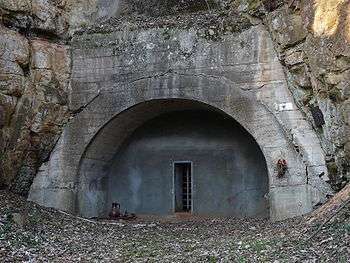Doggerstollen

The Doggerstollen was a subcamp of the Flossenbürg concentration camp in World War II, close to the village of Happurg. It was an underground factory, where the production of BMW aircraft engines was planned. The Doggerstollen was built by approximately 9500 prisoners of whom 4000 died ("Extermination through labor", German: Vernichtung durch Arbeit).
History
The construction work began in May 1944 under the code name Dogger. The underground factory was planned to have an area of 120,000 square metres, as stated by Walter von Linden, director of the "Deutsche Schachtbau" (German Mine Shaft Construction), during one of the post-war trials. Under the guidance of 400 German miners, the prisoners had to work around the clock in shift operation. The companies AEG, Thosti, Tauber, Hochtief AG and Siemens Bau-Union were involved in the construction of the factory. Eight connected galleries were constructed by rock blasting. These contained factory halls five metres high and up to seven metres wide. Before the invasion of the US Army the mines reached a length of 4.03 kilometres. The prisoners had to walk a distance of 5 kilometres from the camp of Hersbruck to the construction site in Happurg every day.
Further reading
- (German) G. Faul: Sklavenarbeiter für den Endsieg. Hersbruck 2003. (Published by the documentation center KZ Hersbruck e.V.)
- Alfons Baier, Dieter Feitag (1996). "Das Doggerwerk bei Happurg (Nürnberger Land) - Zur Geschichte und Geologie einer unterirdischen Rüstungsfabrik" [The Doggerwerk at Happurg (Nürnberger Land) - On the history and geology of an underground weapons factory]. Geol. Bl. NO-Bayern (in German). 46 (3/4). Erlangen. pp.145–174 : 4 Abb., 5 Taf. Zugriff= 31.12.08 (Figure 4, 5 pl Access = 31.12.08). OCLC 633739191.
External links
- (German) Documentation center KZ Hersbruck, Article "Doggerwerk"
- (German) Details about the history and geology